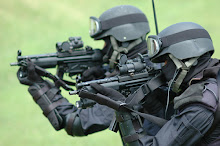
October 10, 2008
Eugene Stoner and ArmaLite designed and built a lightweight, powerful, small-caliber shoulder weapon after the Army asked for help to develop a 5.56x45mm chambered military rifle in 1957.
The Army, looking ahead to a jungle war in Southeast Asia, picked the lightweight design to equip its new, highly-mobile soldier. But the Army did not fully adopt the specific design requirements that made the original AR-15 operate effectively.
No one recognized that the ball powder substituted by the Pentagon had a greater fouling effect on the AR bolt assembly and chamber area. In addition, troops were not properly trained on how to clean their new rifles. The result was a weapon that was susceptible to jamming in the field, giving the new rifle a bad reputation right off the bat.
The poor initial performance, together with the marginal incapacitating ability of the 5.56 round, led to doubts about the Stoner design that linger today. But the mobile warriors of today are frequently getting in and out of vehicles and need a shorter weapon. The loss of active barrel length in the M4 further cuts the overall effectiveness of particular loads of the 5.56 round that many already considered to be too small and weak.
Recognizing the dilemma, military and civilian manufacturers are developing rounds for the AR platform that could bridge accurate lethality and shorter barrels. Two different approaches are strong contenders: the 6.8 SPC (Special Purpose Cartridge) and the 6.5 Grendel.
Both the 6.8 SPC and 6.5 Grendel have a greater potential for immediate lethality than the 5.56, based on a heavier bullet traveling at a comparable speed. During tests, shots taken at distances ranging from 50 to 75 yards with the 6.5 Grendel at medium-sized wild hogs produced many first-round lethal hits, as well as immediate incapacitation. The bullets did not exit but fragmented during passage through the tissue.
The accuracy of 6.5 Grendel and 6.8 SPC was excellent. The groups for each caliber met or exceeded previously published data. The ability to stay on target during full-auto fire was achievable and far exceeded any similar .308-caliber weapon on hand for controllability. Our overall conclusion is that both the 6.5 Grendel and 6.8 SPC demonstrate superior effectiveness when compared to the 5.56 -- transferring more energy using a larger, purpose-formed bullet.
The 6.8 SPC is a well-engineered combination of velocity, accuracy and reliability for combat engagements up to 500 meters. With a trajectory very similar to the .308 WIN, the 6.8 SPC provides almost 50 percent more downrange, terminal-energy than the 5.56 NATO at 100-200 meters. However, at distances greater than 400 yards, performance of the 6.8 SPC is inferior when put up against the .308 Win or the 6.5 Grendel.
The 6.5 Grendel bullet is designed for energy retention during flight and has about twice the mass of the 5.56 NATO, with ballistics superior to the soviet-era 7.62x39 mm round. It maintains a devastating impact on tissue at longer ranges. The flat-shooting round has demonstrated one minute-of-angle accuracy beyond 600 meters, where the performance of the 6.8 SPC falls off.
Overall, both the 6.5 Grendel and 6.8 SPC offer similar hard-hitting short-and-intermediate range performance with .308 accuracy out to intermediate ranges. The 6.5 Grendel has the edge past 600 meters. Given a choice, I would take the better ballistic bullet of the 6.5 Grendel, which has incapacitating lethality for most tactical situations from CQB to out beyond 600 meters. However, the logistical support for the 6.5 Grendel and 6.8 SPC has been inconsistent. In addition, the demonstrated ability of the 5.56 green-tip to penetrate light armor and steel plate better than the 6.5 Grendel or 6.8 SPC will be of interest to operators who might have to take on technicals when under fire.
Although no single caliber will provide the operator with a solution to every tactical problem, many warriors interviewed would still take the M855 5.56 due to overall satisfactory performance and ammo availability. One of the important aspects of the "is the M4 good enough" argument is to ensure that the "real" trigger-pullers have the loudest voice and overriding opinion about what works in the field.
http://www.military.com/news/article/m4-round-has-strong-competitors.html?col=1186032310810



No comments:
Post a Comment